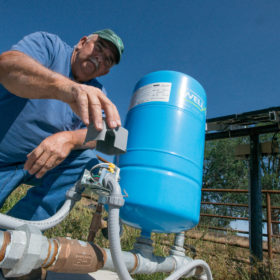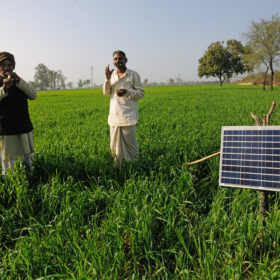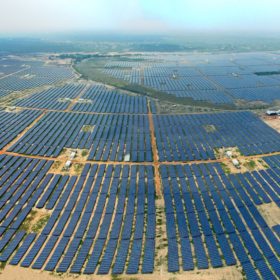Auroville search engine will crowdfund solar power for 100 villages in Tamil Nadu
Sustainable development expert Auroville Consulting has launched the Solar Village Search Engine to help fund its Solar Village Initiative, which aims to power 100 villages in Tamil Nadu with solar by the year 2030.
Hitting 76% of its solar ambition would still be some achievement for India
Analysts are weighing into the debate over the MNRE’s big solar plans, but pointing out that even a partial victory would set the foundation for future solar triumphs.
Rural India a $50 billion market for clean energy innovations
The farming sector offers the largest green energy innovation opportunity, with rice transplanting, pesticide spraying and grain harvesting together having a market potential worth $40 billion – says the Council on Energy, Environment and Water.
India’s solar dreams need storage push – IESA
With a rapid reduction in costs, solar plus storage can be an effective alternative for customers buying peak power from the grid. At the same time, utilities can avoid investments in peak capacity or eliminate load shedding by utilizing these resources.
Cygni Energy raises US$6.4 million, aims to triple solar DC capacity
Hyderabad based Cygni Energy plans to utilize the capital to triple its solar DC solutions production capacity from 4,000 units to 12,000 by H1 2019, develop new technology-enabled products and streamline the product lifecycle, as well as expand nationally and internationally.
India: GST on li-ion batteries cut by 10%
India’s energy storage industry feels the government’s move to reduce GST on lithium-ion (Li-ion) batteries from 28% to 18% will benefit electric vehicles and the renewables sector. The government has also cut GST on the raw materials for battery manufacturing, to jump-start domestic industry.
Global off-grid renewable capacity tripled between 2008 and 2017
While Africa has emerged as a dynamic, fast-moving hub, Asia leads in capacity deployment with its total capacity more than tripling to nearly 4.3 GW in 2017 from 1.3 GW in 2008, finds IRENA. Particularly, in India, a strong policy has pushed deployment of off-grid solar for agriculture and public end-uses.
Falling battery costs to push solar, wind to 50% electricity generation by 2050, but electricity still failing CO₂ reduction targets – BNEF
Solar PV capacity is set to grow 17-fold, and wind six-fold, by 2050, to account for nearly half of global electricity generation, predicts BNEF, while investments will reach US$11.5 trillion. Cost reductions will drive this charge, particularly in the battery market, which will benefit from the EV manufacturing ramp up. Despite this, the electricity sector is still failing to bring CO₂ emissions down to the required levels, with its continued dependence on gas.
India to launch its own battery cell production
India’s PV sector is expanding at a serious pace, creating jobs and further securing energy supply for many businesses. Yet, sourcing battery cell technology at the current rate resulted in annual foreign exchange of Rs. 1012 crore creating deficits, that hopefully can be averted in the future.
Uncertainty and opportunity loom for renewables sector — report
Uncertainty in the renewable energy sector continues to drive a “relentless focus on cost” to soften the impact of protectionism, subsidy cuts and rising interest rates throughout the world, EY says in its latest Renewable Energy Country Attractiveness Index (RECAI) report. But the evolving outlook for project finance, as well as the gradual maturation of technologies such as blockchain, present new challenges and opportunities.















